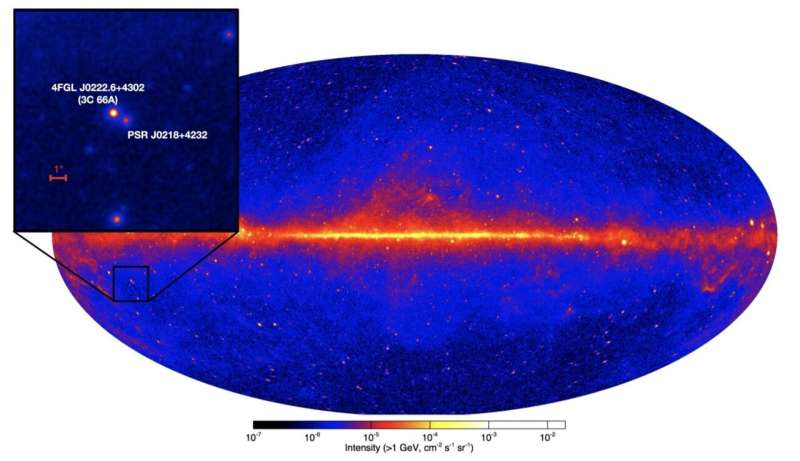September 1, 2021 report
Research inspects the emission from millisecond pulsar PSR J0218+4232

By analyzing the data from NASA's Fermi spacecraft and Major Atmospheric Gamma Imaging Cherenkov (MAGIC) telescope, an international team of astronomers has investigated a millisecond pulsar known as PSR J0218+4232. Results of the study, published August 25 on arXiv.org, shed more light on the emission from this source.
Pulsars are highly magnetized, rotating neutron stars emitting a beam of electromagnetic radiation. The most rapidly rotating pulsars, with rotation periods below 30 milliseconds, are known as millisecond pulsars (MSPs). Astronomers assume that they are formed in binary systems when the initially more massive component turns into a neutron star that is then spun up due to accretion of matter from the secondary star.
At a distance of about 10,270 light years away from the Earth, PSR J0218+4232 (or J0218 for short) is an MSP with a spin period of 2.3 milliseconds. It hosts a white dwarf companion with a mass of about 0.2 solar masses, on a two-day orbit. J0218 has an extremely strong magnetic field at the light cylinder of approximately 100,000 G. Moreover, its characteristic age of about 500 million years and spin-down power of around 240 decillion erg/s, make it one of the youngest and most energetic MSPs known to date.
Previous studies of J0218 have suggested that it may be one of the best candidates to search for very high-energy (VHE) gamma-ray emission (over 100 GeV). That is why a team of astronomers, led by Pablo M. Saz Parkinson of the University of California at Santa Cruz, decided to analyze observational data of this pulsar obtained with Fermi and MAGIC.
"In this paper, we report results from an analysis of 11.5 years of Fermi-LAT data, together with ∼90 hours of data from new MAGIC stereoscopic observations of J0218, collected from November 2018 to November 2019, using the low-energy threshold Sum-Trigger-II system," the researchers explained.
The study found evidence for pulsed emission from J0218 above 25 GeV, but no evidence for emission above 100 GeV (VHE) was detected. The astronomers searched also for possible emission above 30 GeV in the Fermi data but found that, despite the presence of 10 events above this energy, their distribution in phase yielded a p-value that was not significant.
Furthermore, the researchers modeled the broadband spectrum of J0218 from ultraviolet (UV) to VHE gamma-rays using a numerical force-free magnetosphere model for the global magnetic field, computing the individual trajectories of particles injected at the neutron star surface. The model was employed to explain the lack of VHE emission from J0218.
Summing up the results and theoretical modeling, the authors of the paper concluded that it will be very challenging to detect VHE emission from J0218 using the current generation of telescopes. This may change with the Cherenkov Telescope Array (CTA) planned to be operational in 2022.
"The Cherenkov Telescope Array (CTA) is expected to have significantly better sensitivity than MAGIC in the 10–100 GeV range, and this and other pulsars will thus be prime targets for observation," the astronomers noted.
More information: Search for Very High-Energy Emission from the millisecond pulsar PSR J0218+4232, arXiv:2108.11373 [astro-ph.HE] arxiv.org/abs/2108.11373
© 2021 Science X Network





















